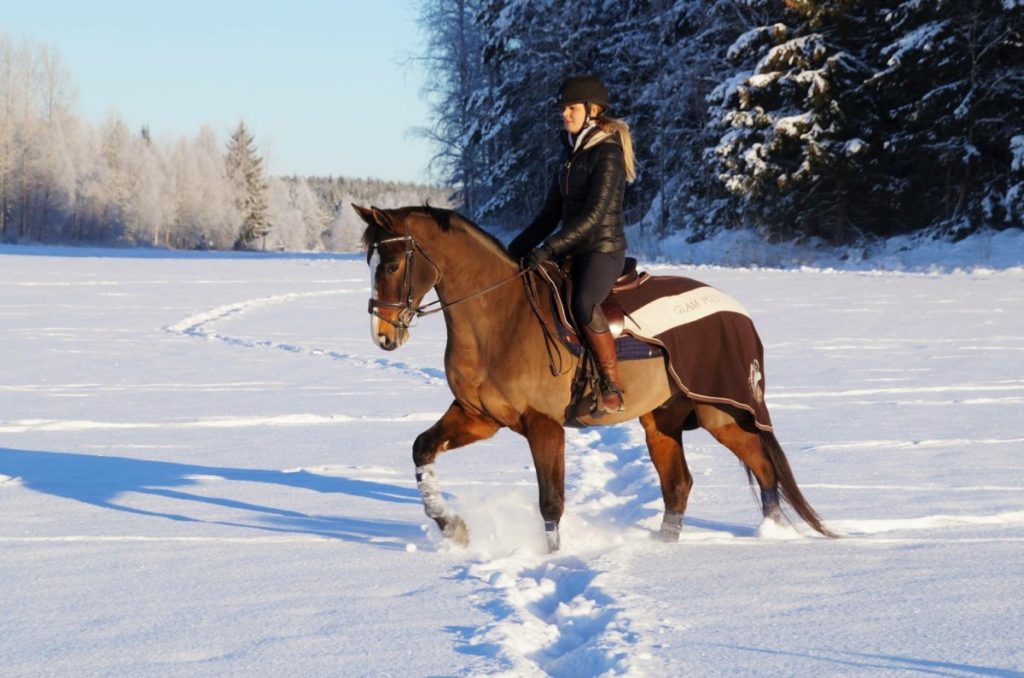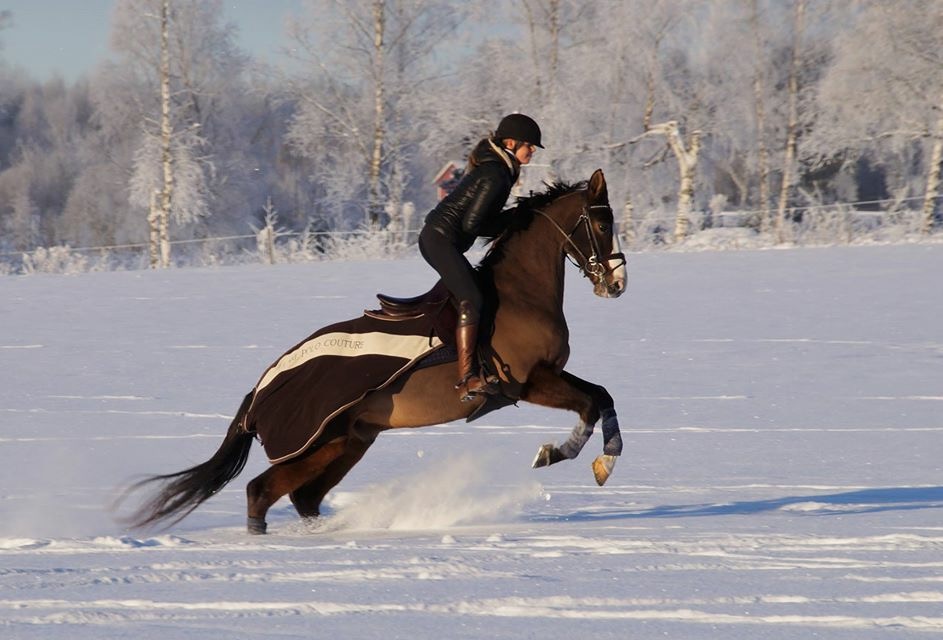Horses are hardy creatures that have adapted to living in harsh conditions under a variety of extreme temperatures. With their ability to withstand such extreme climates, many owners may wonder if their horses are experiencing the harmful effects of winter cold and how they will know if their horses are cold.
You will know if your horse is cold by signs of shivering, huddling for warmth, standing with a clamped tail, and increased appetite. Factors that increase your horse’s sensitivity to cold are age, breed, coat, and condition. Horses with winter coats tolerate cold better than clipped horses.
Each horse’s winter requirements should be determined by their individual conditions, and there is no set rule for when the cold becomes too cold for your horse. If you would like to understand how the cold affects your horses and how to know when you should intervene, please read on.
Do Horses Feel Cold?
Horses are warm-blooded mammals, much like us, and certainly do feel the cold. However, horses have adapted over their evolution to tolerate a greater range of temperatures than we have. Horses grow a winter coat and have specific physiological responses to survive in a range of climates.
If your horse has a decent layer of fat, a well-developed winter coat with a good fluffy loft, they should be able to cope with weather that we would define as extreme cold. However, underweight horses, horses with a clipped coat, or are senior or health compromised should not be exposed to critical temperatures.
Care must be taken when horses are wet. Their cold threshold drops considerably because their coats no longer provide the loft to insulate their bodies. When a horse becomes cold, it will exhibit certain behaviors to alleviate the low temperature.
How to Tell if Your Horse Is Cold
Your horse will give clear signs if the temperature has become too low for their comfort that will alert you to possible problems. You should look out for the following behaviors:
- Shivering: Shivering is a natural response in horses to the cold. These muscular contractions aid the horse to generate heat in their bodies.
- Adapting their body posture: Horses tend to place their rumps towards the wind and form huddles with other horses when they are cold. Often they will stand downwind with their tails tucked in close to their bodies.
- Piloerection: A cold horse will raise its coat hairs to trap warm air between the coat and its skin to keep themselves warm, much like our arm hairs rise when we feel a chill.
- Seek shelter: Horses will naturally seek shelter when their body temperature drops. If they do not have a designated shelter, they will gravitate towards a treed area or natural cover areas in their environment.
- Increase in appetite: Horses generate a fair percentage of body heat by the act of eating and digestion. In particular, hay generates a large amount of internal heat in the digestive process. It is believed that chewing and the increased action by the smooth muscles in the intestine walls during digestion increase the horse’s body temperature.
- Their body temperature is below 99.5℉ (37.5℃): If you are still unsure if your horse is cold, you may take their rectal temperature. Readings of a temperature lower than the above are reflective of hypothermia in horses. Often horse owners feel their horse’s ears for signs of cold, but often that is not an accurate gauge of body temperature.

How Cold Is Too Cold for a Horse?
A body’s ability to cope with a temperature range in the short term without any further energy expenditure is called a thermoneutral zone. Unlike humans with a narrow thermoneutral range of 28°C and 32°C (82.4℉ to 89.6℉), a horse’s thermoneutral range if relatively broad and is between 5°C-25°C (41℉ to 77℉ ).
Without the effects of harsh wind and moisture, horses can withstand temperatures of below -17.78°C (0°F) and even up to -40°F (-40°C) if they have adequate shelter. However, the temperature range that suits horses most lies between 18°F and 59°F (-7.7°C to 15°C) depending on how thick their coat has grown.
For a clipped horse or a summer-coated horse, the cold’s critical temperature is estimated to be below 40°F (4.4°C ). In contrast, thick winter-coated horses’ critical temperature may even be as low as 18°F (-7.7°C). The long winter coats trap warm air next to the skin, which provides insulation from the cold.
If your horse’s coat becomes wet, the critical temperature increases from anywhere between 10°F to 15°F (-12.22°C to -9.44°C.) The influence of wetness on temperature is such that a dry horse can remain warm at 18°F (-7.7°C). In contrast, a wet horse would begin to feel the cold at 33°F (0.5°C). These effects highlight the importance of factoring in wind chill and moisture effects when evaluating the equine environment’s temperature.
How Do You Warm Up a Cold Horse?
The very young or old, thin or unacclimatized horse is more at risk than healthy horses with a good layer of body fat to protect them from temperature drops. The critical temperature for horses is around 40°F (4.4°C) with a thin summer or clipped coat length and 18°F for (-7.7°C) for horses with a thicker coat grown in winter. If your horse shows signs of cold, there are various ways to ensure that your horse is warmed externally and internally.

Increase Your Horse’s Nutrition
With temperatures plummeting in winter, your horse will need extra energy provided by an increased diet to keep its body temperature. Experts suggest an extra 1.3% energy per degree celsius below 0℃ (32°F) with a daily increase of 0.7% to maintain weight levels.
The best type of food to warm your horse is forage, typically in the form of hay. Grain feed does not create the heat increases of hay, which raises body temperature through microbial fermentation.
An average 1000lbs (454 kgs) idle horse’s daily intake of hay should rise 2 to 2.5 pounds (0.9 to 1.1 kgs) to 18 to 18.5 pounds (8.1 to 8.4 kgs) if temperatures drop below 0°F (-17.7℃). This amount should increase further if the horse cannot benefit from a shelter in the winter months.
Provide a Shelter for Your Horse
Horses should be provided with some form of protection from the elements in the winter months. You should ideally provide covered protection or at least allow your horse trees if you cannot provide shelter. If your horse is not exposed to wind and moisture, a healthy horse can tolerate temperatures as low as 0°F (-17.7℃).
Shelter increases your horse’s ability to tolerate low temperatures even up to the levels of -40°F (-40℃) if their condition is healthy and they have a proper winter coat.
Blanket Your Horse
Blanketing your horse is an option to warm your horse if it is suffering from the cold. You should seriously consider blanketing your horse if:
- No shelter is available, and the temperature is less than 5°F (-15℃)
- Your horse has a good chance of getting wet
- Your horse has a clipped coat
- Your horse is not acclimatized to the cold
- Your horse is very old or very young
- Your horse has a poor body condition or is underweight
Can Horses Get a Cold?
Yes, horses can get the equivalent of a common cold, an infectious upper respiratory infection called a URT caused by viruses, bacteria, and stable pathogens. Although cold temperatures do not cause these cold-like symptoms in horses, the time spent indoors in winter may make your horse more prone to infectious diseases.
Horses may react to several pollutants in their stables, such as ammonia released from bedding, mold spores, and dust. Application of good hygiene, ventilation, and stable management techniques are vital to prevent respiratory disease in your horse. Keeping up to date with vaccinations is also crucial in preventing diseases common to horses.
Symptoms of a URT include many similar symptoms to a bad human cold, such as:
- Coughing
- Nasal discharge
- Lack of appetite
- Fever
Conclusion
Although horses have evolved to cope with climatic conditions that we could hardly survive, care must be taken that your horses do not suffer from the cold in winter. Your winter solutions must consider your horse’s age, condition, coat, and environment to be effective. If you properly consider all the potential factors that may affect your horse, you may easily create a solution to keep your horse from becoming too cold.
Sources
- UNM Extension: Caring for Your Horse in Winter
- AAEP: Cold Weather Care
- Science Direct: Exploring the human thermoneutral zone – A dynamic approach
- Science Direct: Caring for the horse in a cold climate
- Science Direct: Thermoneutral zone and critical temperatures of horses
- Vetstream: Hypothermia
- The Horse: Does My Horse Have a Cold?
- NCBI: Markers of respiratory inflammation in horses in relation to seasonal changes in air quality in a conventional racing stable
- Equisearch: Prevention and Treatment of Respiratory Infections in Horses
- MSD: Equine Respiratory Disease
- Ryttarens.se
